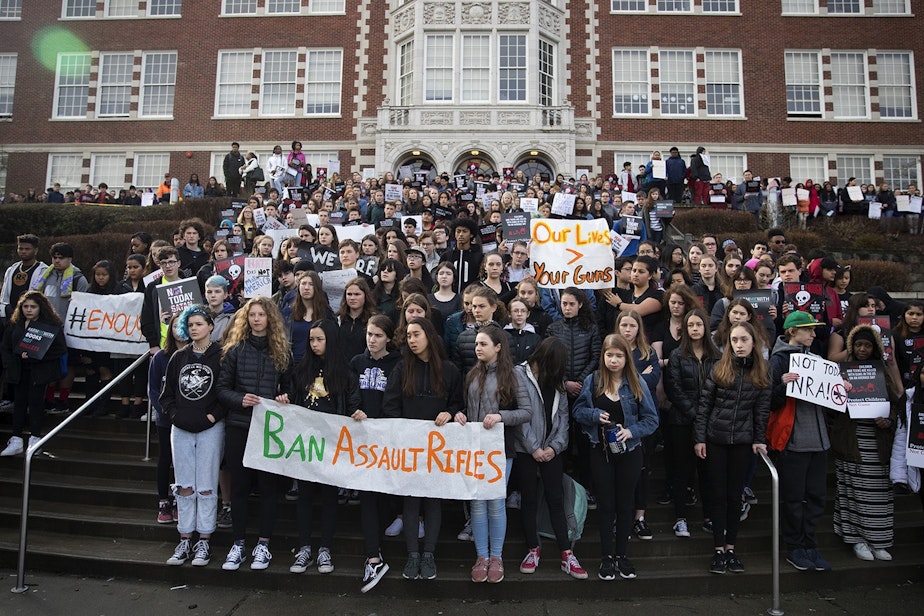How should we prepare kids for a school shooting?

Federal Way Public Schools used to show a video instructing students to "run, hide, fight" in case of a school shooting.
But after concerns from a teacher, revisions have been made to the training. The video was pulled for kindergarten through second grade and edited to remove the “fight” portion for third through fifth grades.
Students in sixth grade through high school are still shown the full video.
“There seems to be a movement at the moment to rely on these types of videos to essentially relay a message that the FBI and others have been using for some time,” said James Densley, associate professor of criminal justice at Metropolitan State University, speaking in KUOW’s The Record.
“Often that training was used with adults, and it’s now being increasingly used with young people, and that’s of course where the controversy lies.”
Sponsored
Densley studies the effects these videos have on young people in a post-Sandy Hook era. He notes that school shootings are still incredibly rare, so it’s a sensitive balance to strike with preparing students.
One example he gives is flying on an airplane: It’s unlikely the plane is going to crash, but you still get some instruction in safety procedures every time you settle in for a flight. Densley said it comes down to presentation.
“We’re not acting out these dramatic plane crashes," he said. "And we’re not seeing images of people jumping out of airplanes and people running through the aisles screaming."
“On the one hand you have to wonder: Is the video, any video, the right medium to be having these types of conversations with young people?" he asked. "And even if it is determined it’s the right medium, what is the tone of the video and what is the message being conveyed?”
Ross Reynolds interviews James Densley and Steve Fisk on 'The Record,' Monday, Feburary 4, 2018
Sponsored
Federal Way isn’t the only school using active shooter training videos. North Central High School in Spokane actually created a video themselves using their own students and school.
Principal Steve Fisk said the idea came after students approached him about how to better prepare for this kind of event after the Freeman High School shooting in 2017.
“When something like that happens so close to you, it creates this anxiety of, ‘what if?’" Fisk said. "Even though it’s rare, you still want empower kids to have the right information.”
The school developed a program that trained staff first, then had staff walk through a presentation with their students along with the video. Fisk said they reached out to people in the community and in the school who were feeling especially anxious to make individual plans.
Sponsored
Densley said it was important to have this sort of “wrap-around” program, but still called for caution.
“By doing these sort of videos and lock-down drills, which many schools now have, there is a risk that normalizes the idea of a school shooting," Densley said. "It could even be handing young people a script of how these things operate. It could create a fascination, it could even create a contagion effect.”
Densley said a lot of the work that needs to be done to prevent deadly school shootings starts with recognizing the struggles and challenges of the people already in the school, particularly those that have expressed issues with suicide.
“A lot of the work that we would do in suicide prevention translates into violence prevention,” Densley said.
“If somebody is threatening to shoot at a school, we could go ahead and punish that, but actually it would be better to think about that as being a cry for help," he explained. "And we could address it appropriately with the right resources and the right intervention.”
Sponsored
If you or someone you know is struggling with suicidal thoughts, please contact one of these resources:
National Suicide Prevention Lifeline: 800-273-8255
Hotline available 24/7. Online chat also available.
Crisis Text Line: 741741
Text from anywhere in the U.S. with a trained crisis counselor. Available 24/7.
Sponsored
Forefront Suicide Prevention (UW)
Information, training, and resources. Not a crisis line.
American Foundation for Suicide Prevention
Information and resources. Not a crisis line
Produced for the web by Kara McDermott.




